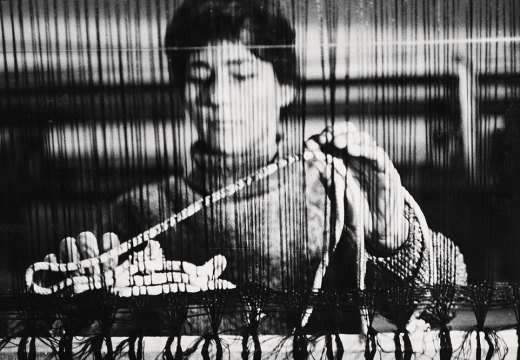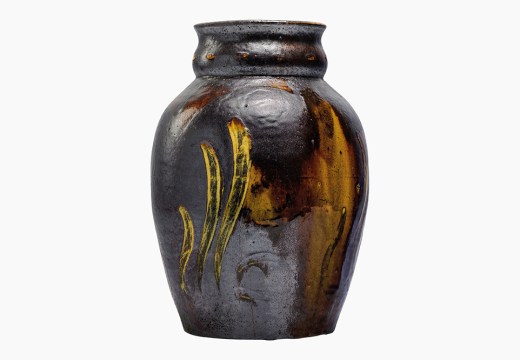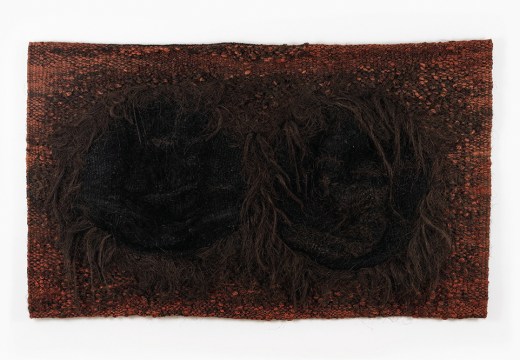From the March 2023 issue of Apollo. Preview and subscribe here.
Thinking about the uneasy relationship between the crafts and the world of progressive fine art, I’m often put in mind of the film Being John Malkovich (1999). It tells the story of Craig Schwartz, a gifted but overlooked puppeteer who discovers a portal into the mind of the actor John Malkovich. Once installed, Schwartz makes Malkovich both adept at his craft and a proselytiser for it – with the result that a series of Hollywood stars publicly announce their devotion to puppeteering. An obscure artistic activity becomes mainstream. Until recently anyone with a committed interest in ceramics or textiles, never mind book binding or radical jewellery, longed for a Malkovich figure to emerge and speak up for these overlooked genres.
Rewatching the film reminded me of the exhibitions held from 2005 until 2011 at Billing Place in west London. There, in a modest terraced house, Anthony Shaw curated his remarkable collection, which is now on long-term loan to York Art Gallery. It was dominated by ceramics, in particular the work of Gordon Baldwin, Ewen Henderson, Gillian Lowndes and Sara Radstone; but the collection also included textiles by Peter Collingwood, and paintings, sculpture, books and ceramics by the largely self-taught outlier Bryan Illsley. Those early millennial openings at Billing Place had the air of a clandestine underground movement. Shaw’s visitors knew they were in the presence of great art that was bypassed, rejected and ignored by the art world.

The Anthony Shaw Collection at Billing Place, west London, in 2011. Photo: Philip Sayer; © The Anthony Shaw Collection
This was paradoxical because during the first two decades of the 20th century, artists in flight from academicism had jettisoned established ways of making. Take the artist Sophie Taeuber-Arp, the subject of a recent ground-breaking exhibition at Tate Modern. She was in the vanguard of multi-media experimentation and after her death her husband Jean Arp paid adoring tribute to his late wife, emphasising her importance in introducing him to new ways of making: ‘Her works have sometimes been referred to as applied art. Both stupidity and wickedness are at the root of this appellation. Art can just as easily express itself in wool, paper, ceramics, or glass as in painting, stone, wood or clay.’ He explained that as a kind of process of purification he and Sophie temporarily renounced paint and canvas as ‘characteristic of a pretentious and conceited world’. But when Arp came to publish a catalogue raisonné of his wife’s work in 1948 he chose to focus only on her paintings and reliefs. Painting and sculpture were reinstated over jewellery, textiles, bead bags and marionettes. He was in step with the times: as the histories of modern art came to be written from the 1940s onwards, Dada heterodox playfulness, which had embraced craft, was codified into a less adventurous flow chart.
These boundaries, which are only now being properly challenged, were created in part by cultural rationalisations after the Second World War. In Britain, key organisations – the Arts Council and the Crafts Council – were created that kept previously intertwined worlds of ambition apart. In North America the critic Clement Greenberg had already narrowed the field of permissible visual art dramatically, deploring what he called ‘medium scrambling’. Greenberg’s strictures soon became irrelevant, but a prejudice against the genres of ‘craft’ continued to be endorsed by artists. Louise Bourgeois’s harsh review of the ambitious show ‘Wall Hangings’ at MoMA in 1969 suggests that for women artists especially, craft was a dangerous association. She wrote that ‘the pieces in the show rarely liberate themselves from decoration’ and were ‘more engaging and less demanding’ than sculpture or painting. Nearly 30 years later, in 1996, little had changed when Agnes Martin expressed palpable irritation at an interviewer’s suggestion that weave constructions by her sometime lover Lenore Tawney might have influenced her paintings.
While writing an obituary of the first director of the Crafts Council, Victor Margrie (1929–2022), I began to reflect on the particular situation in Britain from the 1970s onwards, and also tried to understand the implications for gifted craftspeople. In the early 1970s Margrie had been inspired by the high quality of young graduates coming out of well-funded British art schools in the wake of the conceptually demanding Diploma of Art and Design courses that had been established during the 1960s. Largely because of Margrie’s vision, innovative makers of different generations were encouraged and exhibited – the ceramicists Alison Britton, Elizabeth Fritsch, Carol McNicoll, Jacqui Poncelet and Janice Tchalenko, the metalworker Michael Rowe and the furniture maker Fred Baier, together with more senior figures like the potters Gordon Baldwin and Gillian Lowndes and the weavers Peter Collingwood and Ann Sutton. From 1979 the Crafts Council had a gallery in Waterloo Place on Lower Regent Street, art critics invariably ignoring its excellent exhibitions. But Margrie knew that his work was important, something borne out by the turn to clay and textile in the art world of recent years and the paradoxical ‘rediscovery’ of figures like the late Gillian Lowndes.

‘Housetop’ – nine-block ‘Half-Log Cabin’ variation (c. 1945), Martha Jane Pettway. Souls Grown Deep Foundation, Alabama
Lowndes, although admired by Margrie, Anthony Shaw and her ceramic peers, had a whole career in which she made work that looked like sculpture without being part of the British sculpture world. Six years after her death in 2010, her work was shown by the Sunday Painter gallery in south London and in an accompanying essay the artist Aaron Angell wrote with a sense of rescue: ‘There has been a tendency in craft circles to couch Lowndes’s work in the realm of playfulness – experiments to see what will and will not survive 1300 degrees Celsius.’ In effect he was suggesting that the craft world had let Lowndes down, being not sophisticated enough to understand her intentions when she fired clay, wire and brick together. In fact, the reality was quite different. Lowndes had been valued in all her complexity within the craft world. She was ‘discovered’ because of a dramatic change in the art world, a so-called material turn. What seemed like a discovery had, however, been available all along. This recognition of selected instances of craft happened remarkably suddenly and we are yet to see how it will play out. After all, the modest status of ceramics was still being underlined by the reception of ‘Modern British Sculpture’, a bold show curated by Penelope Curtis at the Royal Academy in 2011. The critics were almost uniformly hostile to the show’s subtleties. What seemed to rile them especially was Curtis’s recuperation of ceramics alongside interwar sculpture.
Since then, textiles in particular are being embraced by the art establishment. In Britain we have seen major exhibitions like ‘Entangled: Threads and Making’ at Turner Contemporary in Margate in 2017, Tate Modern’s survey of Anni Albers in 2019, as well as Sophie Taeuber-Arp in 2021 and the current Magdalena Abakanowicz show, and ‘Ruth Asawa: Citizen of the Universe’ at Modern Art Oxford in 2022. Work by Sutton and Collingwood has been acquired by Tate Britain. Ceramics have had their moment too, from the elegant and thoughtful shows mounted since 2013 by the London gallery Corvi-Mora to Jareh Das’s haunting ‘Body Vessel Clay: Black Women, Ceramics & Contemporary Art’ (Two Temple Place, 2022), and, in the same year, the ravishingly beautiful ‘A Matter of Life and Death’ curated by Jenni Lomax for the Thomas Dane Gallery in Naples.
Some of this revisionary interest links to a very proper desire to show women artists more generously, buoyed up by remarkable recent American scholarship by Elissa Auther, Anna Chave and T’ai Smith in the field of textiles. Less convincingly, a reaction against the digitalisation of all knowledge may account for a turn to tactile creativity. Whatever the reasons, this embrace of craft should be cause for celebration. A handful of craftspeople are being relaunched by energetic and gifted curators within the art world just at the moment when the ‘craft world’, once led by figures like Victor Margrie, is beginning to lose focus, with material-based school and university courses being cut and significant craft galleries struggling to survive. But there are reasons to be cautious about this change.

Installation view of Gordon Baldwin’s exhibition ‘Works 1971–2003’ at Corvi-Mora, London, in 2022. Courtesy Gordon Baldwin and Corvi-Mora, London
There is a tendency to draw these ‘rediscovered’ works of craft, whether by art school educated or vernacular makers, into the story of modern art. Take the Gee’s Bend quilts, initially made by women in an impoverished Black community in Alabama. These quilts, like Shaker and Amish quilts, are often assumed to share the same formalist vocabulary as abstract paintings. What seems to be forgotten is the immemorial textile tradition, which has its own trajectory, one in which ‘modern art’ appears as a mere blip in the history of material culture. Yet viewing Gee’s Bend quilters and their descendants as a species of undiscovered modern art appears to inform both the current show ‘The New Bend’ at Hauser & Wirth in Somerset and the Royal Academy’s ‘Souls Grown Deep Like the Rivers’, opening in March.
The history of modern art has until relatively recently been rationalised into a series of evolutionary, but exclusionary, timelines. An analogy can be made with 19th-century colonisers and their creation of boundaries in the form of charts and maps of Empire. At times it seems as if craft, like the territories of a potential colony, has become a kind of hinterland to be explored, with the art world a well-organised colonial power. The art-world explorers arrive with a sense of wonderment and with their own preoccupations, largely informed by the history of progressive art. Suddenly, for instance, the distinguished and courageously anti-fascist Norwegian tapestry weaver Hannah Ryggen (1894–1970) is ‘discovered’. But why now? Why not before? Then again, the technicalities of fired glazed ceramics and of weaving in all its constructed variousness are presented as both beguiling and perplexing. As an essay in the catalogue accompanying Tate Modern’s Anni Albers show observes: ‘A handloom is hardly the most obvious choice for an artist of the historical avant-garde.’ Craft time and art time are perceived as different. The slow laborious process inherent in weaving comes as a surprise. The very title of the Hayward Gallery’s recent ‘Strange Clay’ suggests a similar puzzlement over the fact of the demanding technologies associated with ceramic. Yet in the catalogue the history of ceramics as it re-emerged as a new 20th-century art form is offered in truncated form. The map is being redrawn with a complex series of local histories of craft and design largely erased.
These are early days. The process of discovery continues. This year the great ceramicist Gordon Baldwin is 91. His career was celebrated in early February at an evening organised by Tommaso Corvi-Mora in a room full of his work, a lively discussion, a phone call to Gordon (who does not travel these days), and plans for a monograph and an exhibition at a public gallery. This was the art world at its most generous and perceptive. And there is scholarship that suggests new ways forward. Jenni Sorkin’s Live Form: Women, Ceramics and Community (2016) is a biographically based study of three women potters – Marguerite Wildenhain, M.C. Richards and Susan Peterson. Making bold claims for their importance, Sorkin argues that craft in general and ceramics in particular allowed them space to ‘innovate, teach and create lasting pedagogical structures’ through process and networks rather than through the creation of prime collectable objects. Connective, persuasive and inspiring, this remarkable study maps new ways of looking at and understanding post-war visual art, with craft and community emerging as a salve to war, gender inequality and the unmoored nature of modernity itself. Sorkin quotes from T.J. Clark’s Image of the People: Gustave Courbet and the Second French Republic, 1848–1851 (1973) to good effect: ‘The real history of the avant-garde is those who bypassed, ignored and rejected it: a history of secrecy and isolation.’ Sorkin’s book suggests that the post-war world of craft might be a good place to search for a new ‘real history’, in ways that go beyond fashionable appropriation and art world ‘discoveries’ in the hinterland of craft.
From the March 2023 issue of Apollo. Preview and subscribe here.
Unlimited access from just $16 every 3 months
Subscribe to get unlimited and exclusive access to the top art stories, interviews and exhibition reviews.














![Masterpiece [Re]discovery 2022. Photo: Ben Fisher Photography, courtesy of Masterpiece London](http://www.apollo-magazine.com/wp-content/uploads/2022/07/MPL2022_4263.jpg)
It’s time for the government of London to return to its rightful home